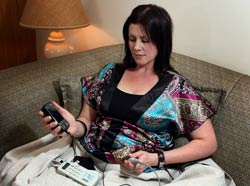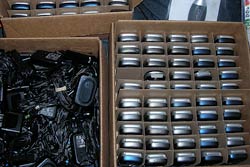Mobile health: a high-tech innovation ideal for low-resource settings
November - December, 2009 | Volume 8, Issue 6
Clinicians, scientists and software developers are increasingly employing a wide range of approaches to mobile health care delivery, electronic medical records management and long-distance research training. Programs vary greatly in terms of technological complexity, scalability and geography. But global health experts agree that innovative mobile communications platforms—particularly those that use cell phones—can effectively address critical shortages of trained health personnel in low-resource settings, both in the U.S. and the developing world.
Facing communications challenges in his antenatal health care project on the Thai-Burmese border, Amnat Khamsiriwatchara from Thailand's Mahidol University turned to smart phones for the solution. Though his team members were operating in an area with no existing cell phone network and were often unable to transmit data in real time, they could upload malaria surveillance information to a server at a health center after visits to the area. The cell phone pilot was so successful, Khamsiriwatchara says there are plans to expand it to include other research topics and to broaden its reach to the Thai/Cambodian border provinces.

Photo courtesy of Microsoft Research
A pregnant woman in Australia uses a
portable monitor and smartphone to transmit
vital data about her fetus, using technology
developed by Microsoft and researchers at
Edith Cowan University.
Cervical cancer, the most common cause of death among Botswanan women, is being addressed through a novel application of mobile technologies. Rachel Gormley, from the University of Pennsylvania, and her colleagues conduct visual inspections of the cervix using acetic acid or household vinegar and take photos using a Samsung U900 cell phone, which features a five-megapixel camera. The images are then transmitted to a gynecologist at a distant location who can provide diagnosis and treatment advice.
Despite technical constraints such as difficulty lighting the cervix, the image quality is suitable for diagnostic purposes, according to Gormley. "The great thing about this technology is that it combats the shortage of specialists—one gynecologist can be connected to multiple practitioners on the ground," said Gormley. "It utilizes infrastructure already in place and it allows for rapid exchange of information, even in areas that don't have consistent access to computers or the internet."
Cell phones also offer a degree of portability and safety that laptops cannot provide. DataDyne researcher Yusuf Ibrahim operates a project in Kenya that uses cell phones to combat the spread of polio by tracking vaccinations, monitoring outbreaks and redeploying resources to combat them. Working in the dangerous Turkana region of Kenya near the border with Sudan, Ibrahim and his associates could not travel safely with laptop computers, making cell phones a logical choice for DataDyne's Episurveyor program.
Rural Australia was the testing ground for a mobile fetal monitoring project. Martin Masek, a researcher from Edith Cowan University, tested low-cost Doppler-based fetal monitors that interface with smartphones, a development that has already benefited indigenous women in remote and rural Australia at risk for premature births and fetal deaths. He learned a valuable lesson about implementing technology. "Not every remote community is the same," said Masek. "What works for one, might not work for another."

Photo courtesy of FrontlineSMS
Non-profit group FrontlineSMS brought 100
cellphones and a laptop to Malawi for a
project designed to improve drug adherence
among rural populations.
In Malawi, the nonprofit organization FrontlineSMS helped the government employ cell phones to mobilize an army of volunteers to provide better care to the nation's rural areas and improve HIV and TB drug adherence. Josh Nesbit, executive director of the nonprofit organization, purchased 100 cell phones and a laptop computer and brought in health workers for text message training. Nesbit and his colleagues also focused on creating a platform based on low-cost, readily available tools such as open-source software and $7 solar phone chargers. Six months later, Nesbit returned to Malawi and found that the health workers had shifted patient follow-up information, HIV/TB data, patient care requests and general logistics to a text message format, saving them thousands of dollars and work hours.
Although there are many different mobile technologies being employed in a variety of ways around the globe, information gathering and sharing is at the core of every m-health project. "Health care is an information business—when you think of health care, you're thinking surgery or drugs people are taking, but health care is actually managing information," said Dr. Bill Tierney, a Fogarty informatics grantee and one of the co-creators of the OpenMRS program, a medical record system used widely in Africa.
"Whether you're gathering it, recording it, moving it—almost everything a health care provider does is managing information," Tierney said. "If it's not done electronically, you're losing efficiency."
More Information
To view Adobe PDF files,
download current, free accessible plug-ins from Adobe's website.